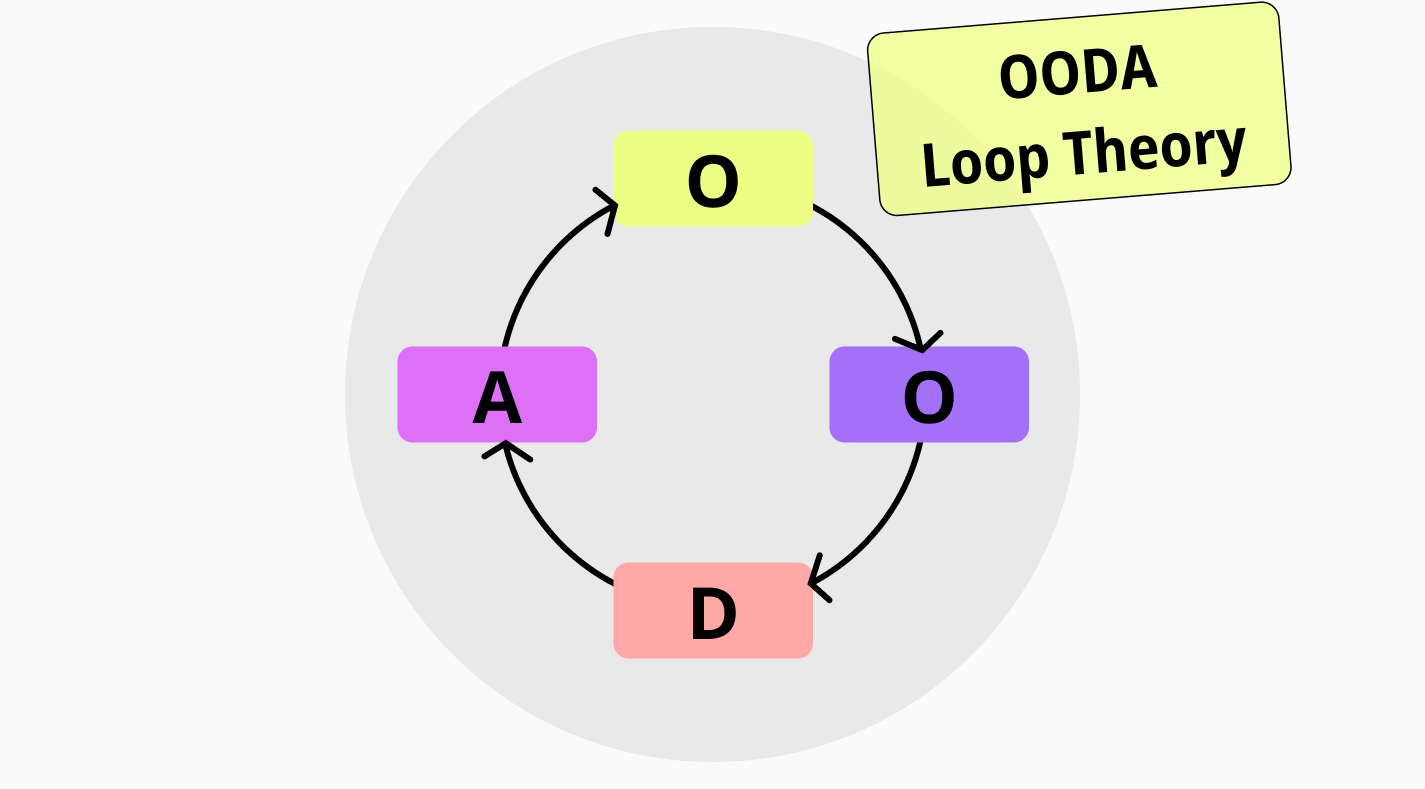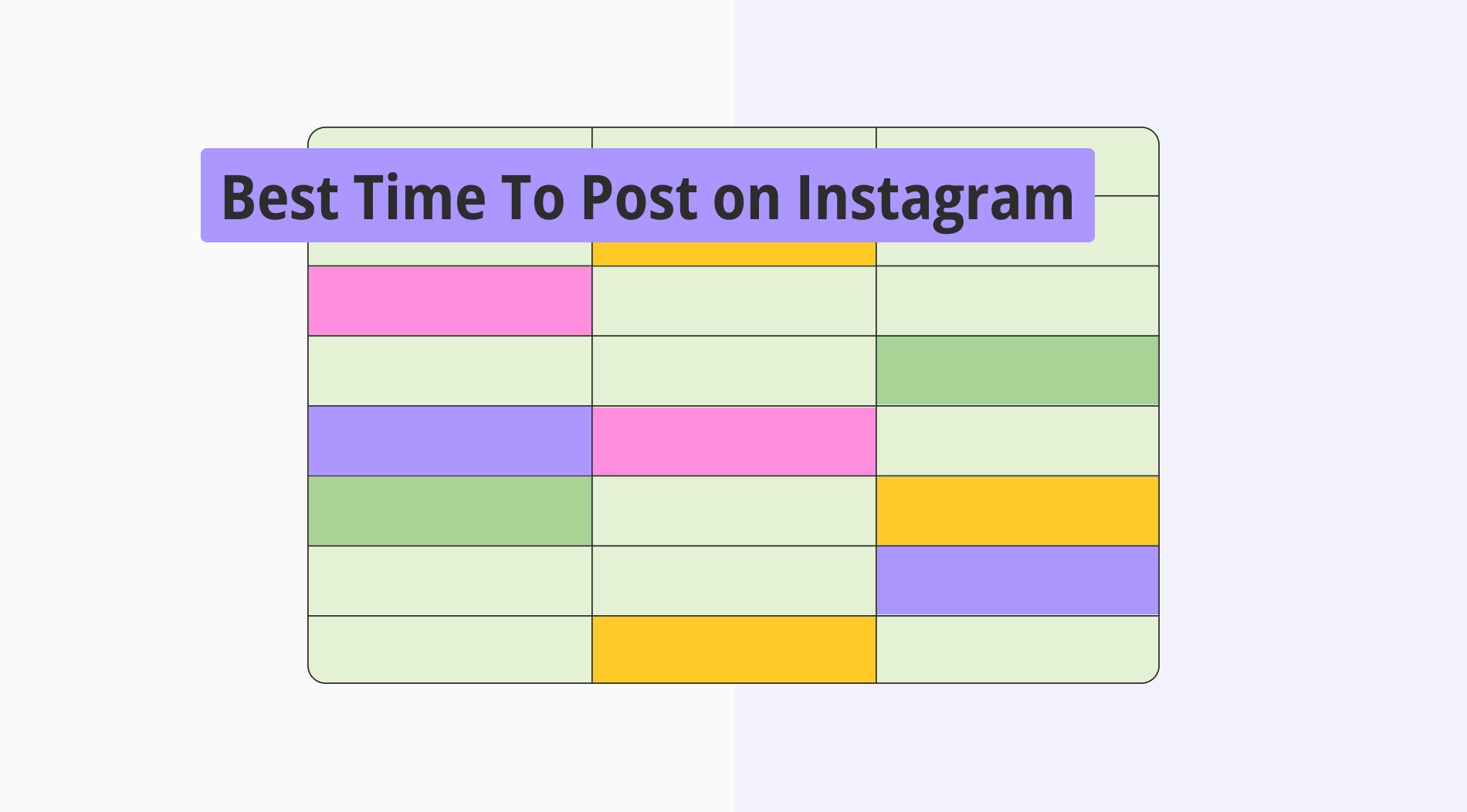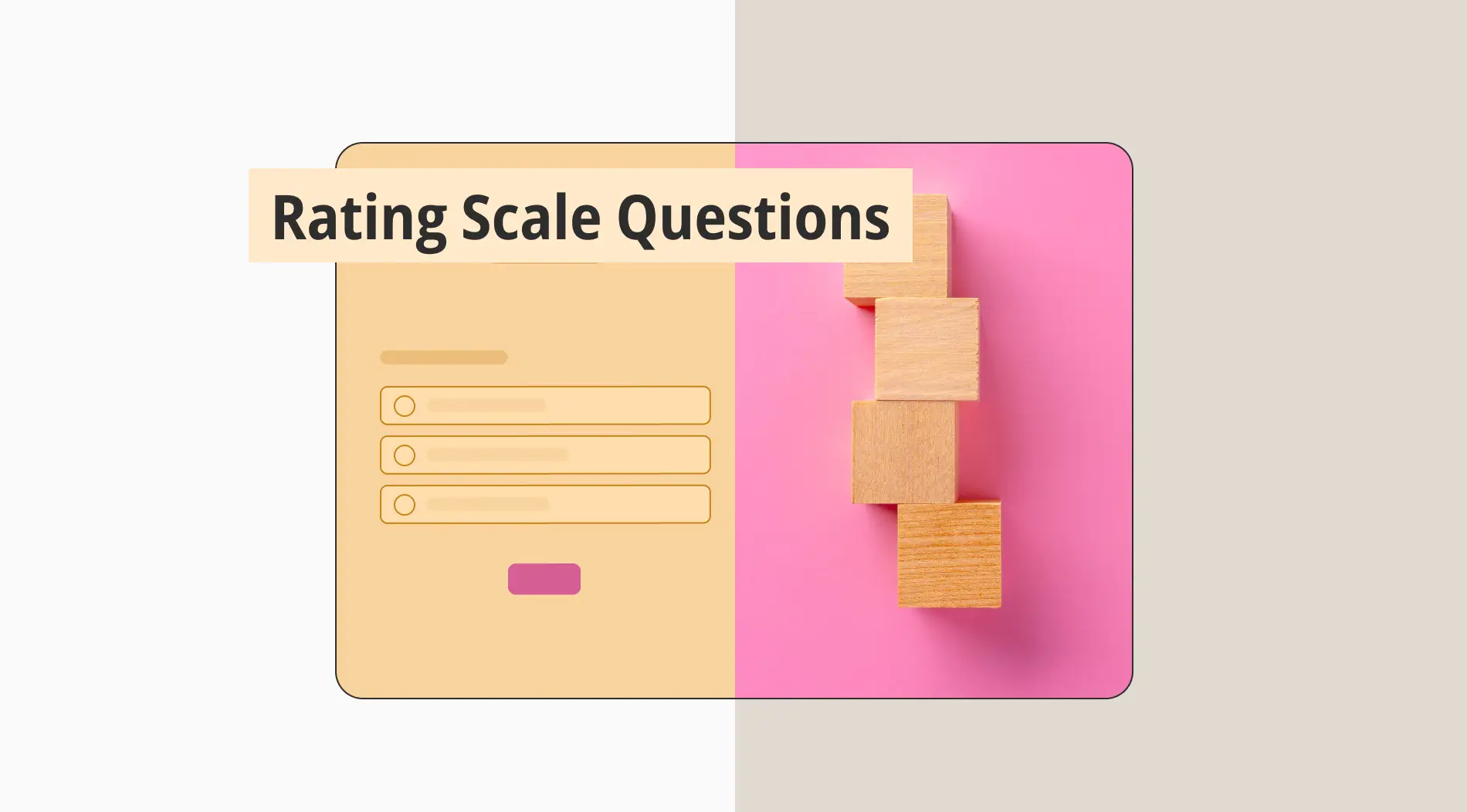In a world where decision processes have become so complex, decision-making models definitely provide businesses with a lot of advantages. They offer a structured approach and clarity and consistency. They also contribute to overall organizational effectiveness and success. There are a variety of decision-making models, and they differ in the core approaches.
Today, we will delve into the OODA Loop theory. It is a decision-making model used to gain an advantage in dynamic and rapidly changing situations. The idea is to go through the steps of the model quickly to adapt to unfolding circumstances. Using this model will definitely improve businesses’ situational awareness.
What is an OODA Loop?
OODA Loop theory is a decision-making framework developed by a military strategist, Air Force Colonel John Boyd, and stands for Observe, Orient, Decide, and Act.
The model involves improving reaction time and adaptability in changing situations. It encourages cycling through the four stages to make quicker and more effective decisions.
Although the framework originated from the military, it also applies to a variety of fields, including business and sports. Essentially, it works in any field requiring agile decision-making. The OODA loop differs from the other decision-making models in that it involves disciplined adaptability and making quick decisions in accordance with evolving conditions.
Why to use the OODA Loop
The OODA loop provides a structured approach to decision-making. It also emphasizes agility and adaptability in dynamic situations. Following each step of the framework may help you enhance situational awareness and take swift decisions and actions. These factors make it a valuable tool for navigating through complex scenarios. Let’s take a more detailed look at its benefits:
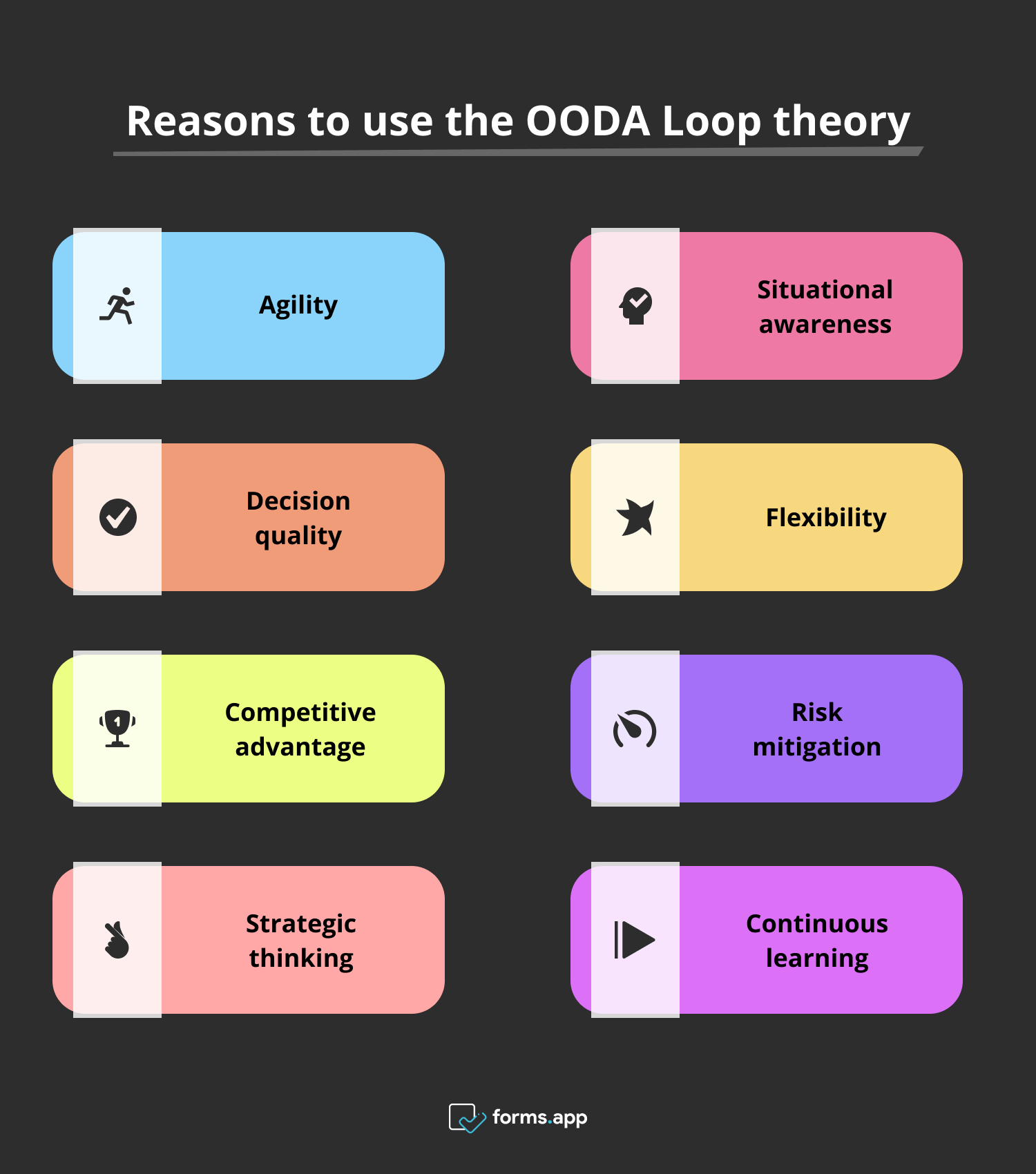
Benefits of the OODA Loop Theory
- Agility: Give quick responses for dynamic situations and speed up your decision cycles. It will ensure that your organization will remain adaptable.
- Situational awareness: Pay more attention to the situation and find better options. Benefit from the advantages of OODA loop situational awareness.
- Decision quality: Get a comprehensive understanding of the situation and make informed decisions of good quality.
- Flexibility: Make it easier to change your plans when you learn new information and ensure adaptability.
- Competitive advantage: Leverage the OODA loop in business and be one step ahead of your competitors.
- Risk mitigation: Observe and orient to changes and identify potential risks early, which enables you to take proactive measures.
- Strategic thinking: Enhance your decision-making through a good analysis and become a better decision-maker.
- Continuous learning: Create a culture of learning and improvement, ensuring better options for future scenarios.
The OODA Loop model
The OODA Loop model is one of many mental models helping us orient phases and make better decisions for both the short and long term. Not only is it a military strategy, but also a perfect framework for competitive businesses and crisis management. Let’s take a closer look at the steps, also known as the cycles, of this model:
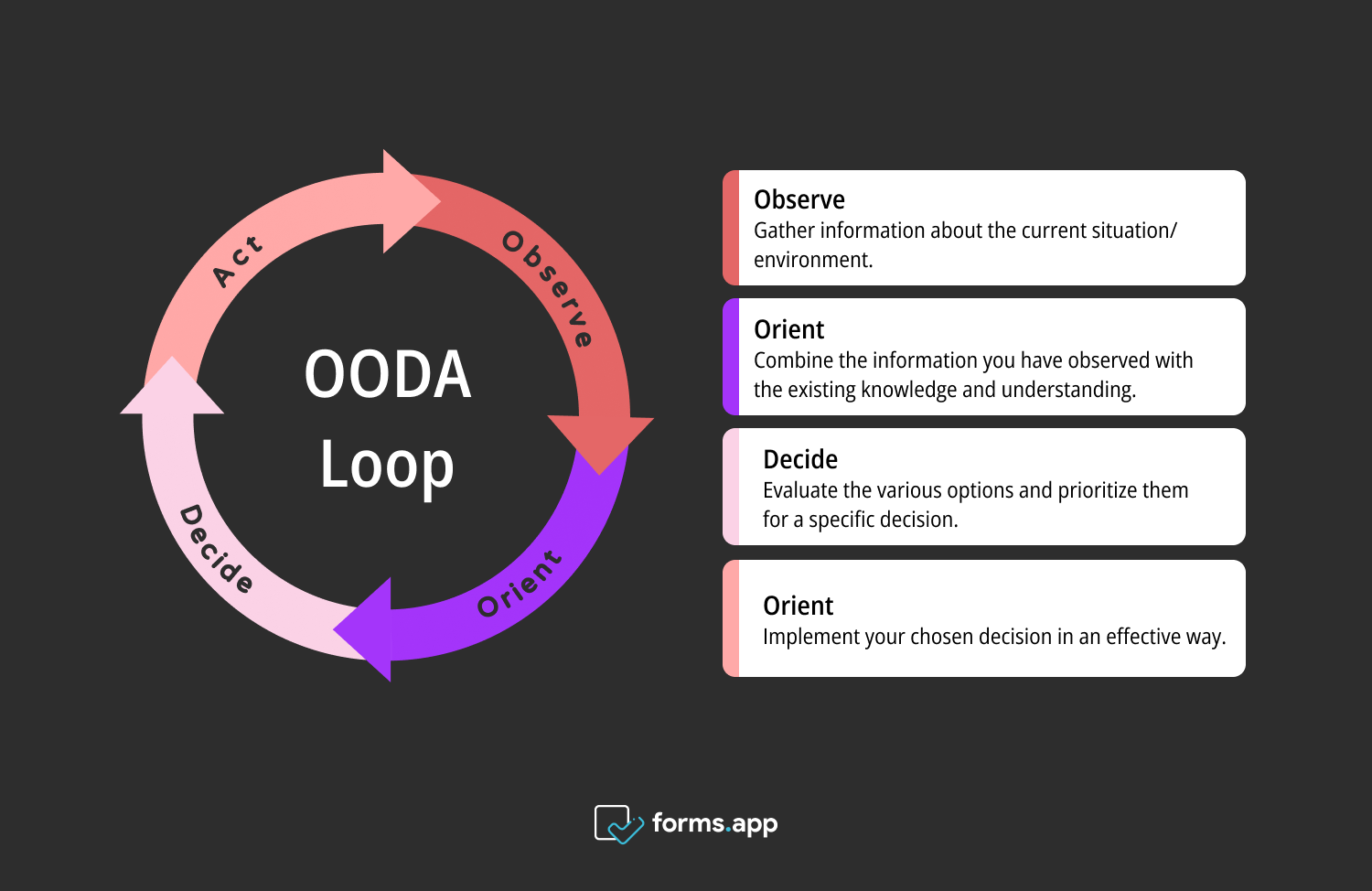
The OODA Loop model
1. Observe
The first step of this model involves gathering information about the current situation/environment. It also requires keen observation and assessing the situation. You can track relevant details and recognize the patterns and anomalies. Comprehensive data collection sets the foundation of this model because it will determine how the next steps will be taken.
2. Orient
The second step of the OODA Loop model is orienting. This means you need to combine the information you have observed with the existing knowledge and understanding. This step also requires analyzing the context and assessing your capabilities. It will also enable you to understand the broader implications of the situation and to shape your decision.
3. Decide
The Decide phase involves choosing a course of action based on the observation and orientation. In this step, you will evaluate the various options and prioritize them for a specific decision. Timeliness is very important because of the dynamic nature of many situations.
This is the step where the OODA loop differs from many other decision-making models. While some of the models require analyzing thoroughly and involve following various stages before making any decision, the OODA loop encourages to make up your mind after you observe and orient quickly.
4. Act
This step requires acting swiftly on the decided course of action. This is the step that distinctly separates this model from other decision-making models. You need to implement your chosen decision in an effective way. Also, it involves adapting to evolving circumstances. The main idea is to execute the idea immediately and recognize that the situation may continue to change.
The reason that this model is called “OODA Loop” is that this is actually a loop. You can repeatedly use this model. Because, when the situation changes you will need to observe, orient and decide for another quick action. The OODA loop problem solving requires addressing different problems coming along after each action.
Example of the OODA Loop model
So far, we have covered the OODA Loop model in detail and with its advantages. Air Force fighter pilot John Boyd developed this plan in the '60s after the Korean War, but this model is also usable in today’s complicated and competitive industries and businesses. Let’s look at some OODA loop examples to better understand the model.
Scenario: Your competitor is after you!
Imagine that you launched a technology company, and the business is going well. But, you face an unexpected market shift due to the emergence of a disruptive competitor. Your competitor is going after your clients, and this is not good for your business. Here is what you do in accordance with the OODA Loop: Observe, orient, decide, and act:
- Observe: You can start by closely monitoring your competitor’s moves. Look at what has changed in the recent months and what caused a decrease in your sales. You have observed that they analyze market trends, customer feedback and competitor strategies to gain advantage.
- Orient: With valuable insights gathered, you can evaluate your own strengths and weaknesses compared to your competitors. You will identify key areas where you can surpass their performance. These areas might be customer support, product customization, and existing customer loyalty.
- Decide: Based on your observations and orientations, you or your team can now shape your informed decisions. You have decided to improve your customer support and concentrate your marketing campaign on your unique features. You have also decided to contact other companies for collaboration.
- Act: You swiftly implement these decisions. Since you previously observed your customers were dissatisfied with your services, you started providing enhanced support services and personalized solutions. Meanwhile, you have also started a new marketing policy to showcase the unique features of your products.
As a result, you have observed something is going wrong in your business and this was because of your competitor. You have oriented yourself towards identifying problems and found them. Based on this, you have given a decision and immediately implemented it without having to face more difficult problems.
Remember, this is a loop. Probably, your competitors will try other moves to get your customers after your courses of action. When you encounter a new problem, you can continue cycling through these steps and adapt to evolving and competitive landscapes. Each time, you will get better at making more effective decisions.
When to use the OODA Loop
The OODA Loop model best applies in scenarios involving complexity and uncertainty and requiring swift changes. It will prove effective in dynamic environments and competitive industries, as well as crisis management and innovative pursuits. Although it emerged as a military decision-making framework and is widely used in military operations, here are some examples of when to use the OODA loop:
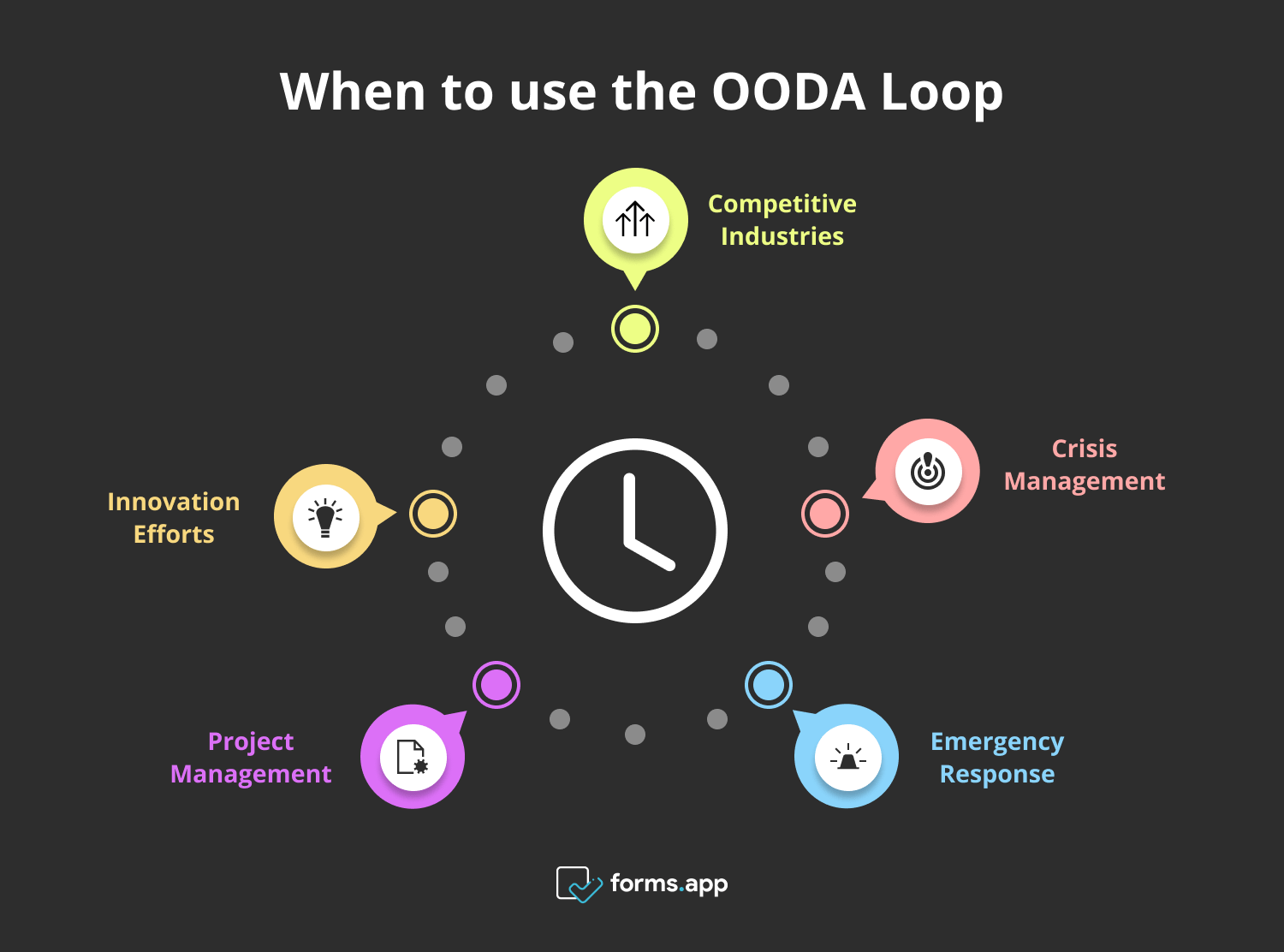
Right times to use the OODA Loop
- Competitive Industries: When you face rapidly evolving situations, particularly in competitive businesses, you can make quick adjustments and respond properly.
- Crisis Management: In crises and high stake situations, it helps manage uncertainties and allows you for speedy responses for emerging challenges.
- Emergency Response: Emergency situations sometimes deprive us of our best judgment. This model helps quickly assess and address unfolding situations, which is specifically useful for emergency responders.
- Project Management: It helps you identify and respond to unforeseen issues in a complex project and contributes to the project's success.
- Innovation Efforts: When encouraging innovation for plans, projects, or companies, the loop can support flexible and responsive strategies.
Frequently asked questions about the OODA Loop theory
We have seen it in a scenario for a more comprehensive understanding. It is a bit different than the other decision-making models. One OODA loop criticism might be that the model requires you to act swiftly after you decide. But this very difference can take you one step ahead of your competitors. Here are some of the FAQs about this different model:
PDCA (Plan, Do, Check, Act) and OODA (Observe, Orient, Decide, Act) are both decision-making and improvement models. But they come from different contexts and serve different purposes. They also have differences in terms of their focus on processes and making decisions.
PDCA is more associated with quality management and continuous improvement. It was popularized by W. Edwards Deming and is more widely used in industries like manufacturing and healthcare to optimize processes. OODA, on the other hand, was developed by a military strategist and is used in fast-paced and dynamic environments. It emphasizes agility, adaptability, and swift decisions.
The OODA loop was developed by Colonel John Boyd, a military strategist and United States Air Force fighter pilot. Boyd worked on the OODA loop during the late 20th century, primarily in the 1960s and 1970s. Boyd’s work on the OODA loop, initially intended for military strategists, has become influential in understanding decision-making processes in rapidly changing environments.
The duration of the OODA loop process can vary widely depending on the context and the complexity of the situation. In the military, soldiers are expected to decide on a course of action in mere seconds to minutes. Of course, this will not be the case in businesses. This model emphasizes speed and agility to outperform your competitors and adversaries.
OODA is an abbreviation for the decision-making framework developed by U.S Air Force Colonel John Boyd. It stands for “Observe, Orient, Decide and Act”. These are steps designed to enhance agility and adaptability particularly in dynamic and rapidly changing environments. It can be used not only for military strategies but also for businesses.
The OODA loops have various benefits when performed: agility, adaptability, decision quality, situational awareness, efficiency and competitive advantage. The OODA loop's strength is the ability to enhance your or your company’s responsiveness and resilience in dynamic and uncertain situations. You can use the steps as a loop to continue addressing the new problems as well.
Conclusion
In conclusion, the OODA loop model is a decision-making framework for fast-paced and complex situations. Although it originates from the military, it is highly applicable in today’s businesses, where companies need to act swiftly. You can continue using the steps in a cycle to address the problems occurring after your decision and courses of action.
In this article, we have given you the full guide to the OODA loop, which is a decision-making model. We have witnessed its practicality in different environments. We have seen a scenario about using the OODA loop in your business.Now, you know a lot more about the OODA loop than before, why don’t you start using it?
Fatih is a content writer at forms.app and a translator specializing in many text domains, including medical, legal, and technical. He loves studying foreign languages. Fatih especially likes to create content about program management, organizational models, and planning tools.
